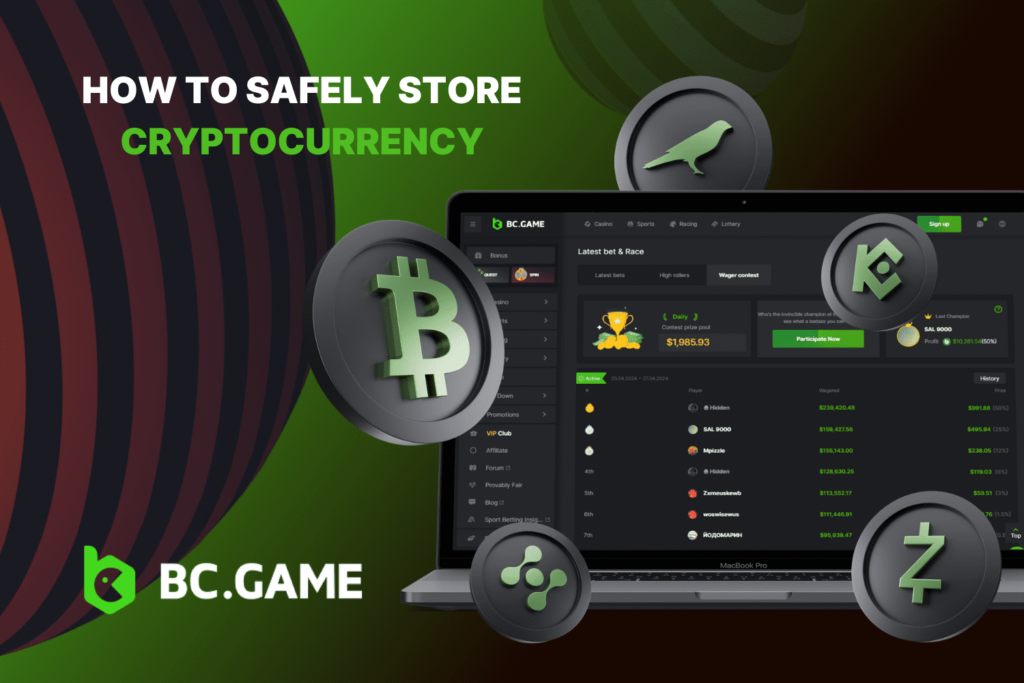
Cryptocurrencies, like Bitcoin and Ethereum, have become widespread due to their decentralized finance and high returns. As they gain popularity, the focus shifts to security. Safely storing cryptocurrencies is crucial for safeguarding the digital economy and reducing the risk of cyber threats.
What are cryptocurrency wallets and why are they needed?
Cryptocurrencies are digital currencies that use blockchain technology for secure, transparent, and decentralized transactions. They are used for various transactions, including buying goods and investing. Cryptocurrency wallets store private keys, which are essential for accessing assets. Loss or compromise of these keys could result in irretrievable access to digital assets. The irreversible nature of blockchain transactions, without third-party guarantees, underscores the need for stringent security practices. To protect private keys and maintain a secure cryptocurrency wallet, users must use reputable and secure wallets.
Types of Crypto Storage
In the contemporary digital era, cryptocurrencies have transcended the realms of niche online forums to become a mainstream financial phenomenon. The meteoric rise of digital currencies like Bitcoin, Ethereum, and countless others has not only reshaped the landscape of investment and commerce but has also ushered in a new age of financial autonomy and innovation. The evolution of crypto storage solutions reflects the growing need for security in an increasingly digitalized world, highlighting the importance of robust and secure mechanisms to keep digital wealth safe from theft, loss, and cyber threats.
Crypto Exchange
Cryptocurrency exchange are electronic emporiums where individuals might procure, vend, or barter cryptocurrencies for other digital tender or orthodox currency akin to US dollars or Euro. These platforms act as the pivotal scaffolding for the trading and liquidity of cryptocurrency assets, executing several quintessential roles:
- Market Making: By matching buyers with sellers, exchanges provide liquidity and enable the discovery of prices for cryptocurrencies.
- Secure Transactions: Exchanges offer a secure environment for conducting transactions, often implementing advanced security measures to protect funds and personal information.
- Wallet Services: Many exchanges also provide best wallet for crypto services, giving users a place to store their digital assets.
- Information Services: They offer market information, including price charts, transaction volumes, and market depth.
Differences Between Centralised and Decentralised Exchanges
- Centralised Exchanges (CEX): Administered by a pivotal sovereign (a consortium or syndicate) that orchestrates the barter of cryptographic assets. Patrons of concentric agoras consign their pecuniary resources directly with the agora, which subsequently orchestrates barter in-house. Concentric agoras are distinguished for their copious liquidity, accelerated barter velocities, and simplicity of utilization, albeit they necessitate patrons to confide in the agora with their assets.
- Decentralised Exchanges (DEX): Function devoid of a pivotal sovereign. Barters are orchestrated directly amongst users (peer-to-peer) through an automatized procedure. DEXs are extolled for their bolstered security and anonymity, as they obviate the necessity for users to allocate their assets to the agora, diminishing the peril of cyber incursions and dupery. Nevertheless, they may encounter deficits in liquidity and decelerated barter velocities.
Risks on Centralised Exchanges
- Security Breaches: Centralised exchanges are attractive targets for hackers due to the vast amounts of cryptocurrency they hold.
- Operational Risks: Mismanagement, technical failures, or operational issues can lead to loss of funds or downtime.
- Regulatory Risks: Changes in regulations can affect the operation of exchanges, potentially leading to the freezing of assets or shutdown of the exchange.
- Counterparty Risks: The risk that the exchange will not fulfill its obligations (e.g., withdrawal requests).
Impact of Negative Events
Events like exchange bankruptcy or fraud can have significant impacts, including the loss of user funds, decreased market confidence, and increased regulatory scrutiny. Users might lose access to their assets permanently in such cases.
Minimising Risks
To minimise the perils inherent in cryptographic currency exchange, patrons can:
- Employ Esteemed exchange: Opt for exchanges noted for robust safeguarding antecedents and laudable standing.
- Activate Safeguarding Functions: Employ biometric verification, robust cryptograms, and other accessible safeguarding functions.
- Spread Assets: Eschewing the consolidation of all valuables in a singular exchange and utilizing personal depositories for protracted conservation diminishes jeopardy.
- Remain Enlightened: Maintaining awareness of the exchange’s statutes, market dynamics, and pertinent dispatches aids in executing informed choices.
Pros and Cons of Exchange Storage
| ✅ Pros: | ❌ Cons: |
| Convenience: Effortless ingress to chattels for bartering. | Security Risks: Potential for hacking and theft. |
| Features: Admittance to manifold bartering duos, plenitude, and additional fiscal apparatuses. | Dependence: Reliance on the exchange’s integrity, security, and solvency. |
Hot Crypto Wallet
In the cryptocurrency domain, fervent pouches denote digital repositories tethered to the internet, fostering rapid and expedient admittance to holdings for dealings and commerce. These pouches juxtapose with frigid pouches, which remain offline and serve for protracted conservation of digital resources.

Features of Hot Wallets in Cryptocurrency Exchanges
When your cryptocurrency exchange account includes a wallet feature, it essentially functions as a hot wallet because:
- Accessibility: It’s online and readily accessible for making quick transactions.
- Integration: It’s integrated with exchange services, allowing for immediate trading.
- Convenience: Offers user-friendly interfaces for managing assets.
- Vault-Linked vs Non-Vault-Linked Hot Wallets
- Vault-Linked Hot Wallets are connected to a more secure storage area or “vault,” which may require additional authentication steps to access larger sums of cryptocurrency, enhancing security.
- Non-Vault-Linked Hot Wallets do not have this extra layer of security and offer direct and immediate access to all funds, making them more convenient but potentially less secure.
Risks with Non-Vault-Linked Hot Wallets
- Security Vulnerabilities: Susceptible to hacking and phishing attacks due to their constant internet connection.
- User Error: More prone to risks associated with user mistakes, such as falling for scams or sending funds to incorrect addresses.
Prevention Measures:
- Institute robust, distinctive passcodes and activate dual-authentication mechanisms.
- Remain alert to deceitful schemes and malevolent software.
- Consistently refresh purse applications to mend potential defense flaws.
- Perils stemming from Web Linkage.
Interfacing hot wallets with the cybersphere renders them susceptible to:
- Cyber Attacks: Hackers could exploit security flaws to access your funds.
- Baleware: Maleficent codeware might purloin your certifications and valuables.
Protection Strategies:
- Implement exhaustive protective software and sustain contemporaneously updated bulwarks.
- Cultivate cautious web navigation practices and eschew engaging with dubious hyperlinks.
- Contemplate the utilization of a singular apparatus exclusively for cryptocurrency dealings.
Pros and Cons of Hot Wallets
| ✅ Pros: | ❌ Cons: |
| Convenience: Immediate access to remunerate for mercantilism or transpositions. | Security Risks: Higher vulnerability to online threats. |
| User-Amiable: Ordinarily possess instinctive interfaces appropriate for neophytes. | Reliance on Third Parties: Dependent on the wallet provider’s security measures and policies. |
Cold Storage
Crypto cold storage wallets, within the cryptographic currency sphere, serve as conservation systems that sequester digital holdings in an offline manner, disjoined from the cyberspace, thus proffering an escalated tier of safeguarding. This absence of online connectivity delineates the paramount divergence between frigid repositories and their thermally opposed counterparts, known as fervent repositories, which are interlinked with the internet and contrived for more recurrent utilization and exchanges.
Types of Physical Devices for Cold Wallets
- Hardware Repositories: Esoteric tangible apparatuses devised for the fortified preservation of cryptographic currency clandestine ciphers in an off-grid manner.
- USB Apparatuses: Rudimentary incarnation of frigid repository wherein a safeguarded USB might harbor clandestine ciphers or coffer data, albeit not as impregnable as hardware repositories.
- Papyrus Repositories: Tangible manuscripts embodying a cryptographic currency locus for the accumulation of capital and a clandestine cipher for disbursing or reallocating resources.
Features of Cold Wallets
- Safeguarding: The disconnected disposition significantly dwindles the jeopardy of cyber intrusion and unsanctioned entry.
- Dominion: Proprietors retain absolute dominion over their clandestine ciphers and, by extension, their holdings.
- Recuperation Alternatives: Numerous frigid repositories proffer recuperation maxims or auxiliary selections to reclaim holdings in the event of apparatus misplacement or damage
Paper Wallets vs Physical Devices
Albeit vellum receptacles proffer an ex-limnetic conservancy modality, their predilection has waned vis-à-vis corporeal apparatuses akin to ferruginous safe crypto repositories because:
- Endurance: Parchment may deteriorate or be facilely compromised juxtaposed to sturdier contrivances.
- Miscalculation by Operator: The protocol of engendering and securely preserving a papyrus depository is more susceptible to blunders and can be less instinctual than employing a contrivance wallet.
- Operationality: Contrivance vaults frequently proffer ancillary functionalities such as visual display units for the corroboration of transactions and patronage for a plethora of digital currencies.
Advantages of Cold Storage
Compared to hot wallets, cold storage crypto offers:
- Augmented Safeguarding: Substantially diminishes the hazard of cyber perils and unsanctioned ingress.
- Proprietorship: Custodians wield exhaustive dominion over their holdings devoid of dependency on auxiliary safeguarding stratagems.
Pros and Cons of Cold Storage
| ✅ Pros: | ❌ Cons: |
| Elevated Safeguarding: Optimal for protracted preservation of substantial quantities of cryptographic currency. | Diminished Expediency: Procuring and reallocating holdings may manifest as more onerous and protracted. |
| Detached Defense: Insusceptible to cybernetic incursions and malignant software. | Peril of Misplacement or Impairment: Corporeal apparatuses may succumb to misadventure, detriment, or malfunction, culminating in conceivable forfeiture of holdings barring the upkeep of adequate replicas. |
Best way to store crypto
Cryptocurrency conservancy necessitates equipoising approachability and safeguarding, with tepid depositories proffering facile ingress for recurrent trafficking and frigid depositories bestowing superior safeguarding. Nascent interchange paradigms like decentralized bourses (DEXs) and avant-garde platforms endeavor to endow users with augmented dominion over their digital opulence. Autarkic conservancy is favored by those who yearn for dominion, safeguarding apprehensions, and confidence in tertiary custodians. Sagacious investors frequently employ an amalgam of tepid and frigid depositories to equipoise safeguarding with liquidity. Paramount considerations encompass the quantum of crypto, trafficking frequency, user’s technical prowess, and conservancy solution’s distinctive safeguarding attributes. The quintessential conservancy method ought to harmonize with an individual’s investment strategy, safeguarding forbearance, and simplicity-of-use predilections, ensuring asset safety and convenience.
FAQ
Cryptofinance repositories can be ensconced within electronic receptacles, bifurcating into duo principal categories: thermic receptacles, interlinked with the cyberspace, facilitating unencumbered ingress for pecuniary exchanges, and frigid receptacles, disjoined from the web, endowing augmented safeguarding for protracted conservation.
Cryptocurrency might be conserved within thermogenic repositories (cyber, software-centric), cryogenic vaults (non-cyber, apparatus contrivances or papyrus receptacles), and upon cryptographic currency exchanges. Every tactic proffers divergent echelons of safeguarding and expedience.
To select the utmost fortified strategy for safeguarding digital currency, prioritize frigid conservation solutions such as apparatus purses for their offline safeguarding against cyber perils. Ascertain the elected strategy proffers sturdy safeguard attributes, such as sophisticated ciphering and backup/restitution alternatives, and conforms with your individual safeguard rituals and the worth of holdings you plan to conserve.













